Every year in May or June, dragon boat races are held all over the world. There are races in Hong Kong, San Francisco, New York, London and everywhere in between. These races originate from the Chinese celebration of the Duan Wu Festival (端午節) on the fifth day of the fifth month of the Chinese lunar calendar, which this year falls on Thursday the 28th of May. The most widely told story of the origin of the festival is that it commemorates the death of Qu Yuan (屈原), a patriotic minister and poet to the court of Emperor Huai (楚懷王) of the Chu Kingdom (楚國) during the Warring Sates period (春秋戰國) around 300 BCE. After serving the emperor loyally for many years, Qu Yuan ran afoul of court politics and was banished. He was devastated and started writing poetry lamenting the loss of the emperor’s favor and the decline of his native kingdom. Saddened by the eventual fall of the Chu Kingdom and the death of Emperor Huai he killed himself in the Mi Luo River (汨羅江). However there is a deep dark secret that is not often discussed.
In 1944 Sun Chizhou (孫次舟), a Chinese literature professor in Sichuan, published an article asserting that Qu Yuan was the homosexual lover of the emperor. Professor Sun quoted passages from Qu’s epic poem of lamentation “Li Sao” (離騷). In it the poet described himself as a “beauty” in feminine term (美人) and referred to the emperor by the term “lingxiu” (靈修), which is commonly used by women to refer to their “lovers.” Ever since this essay was published there’s been endless controversies about Qu’s sexuality. Most Chinese scholars continue to insist that this suggestion is absurd. But you can decide for yourself by reading the classic work if you understand Chinese.
After Qu Yuan killed himself, according to the legend, people made rice dumplings wrapped in leaves and scattered them in the river to prevent the fish from devouring the poet’s body. For this reason the modern day Duan Wu Festival celebration always includes zongzi (粽子).
These rice dumplings are wrapped in bamboo leaves and come in regional varieties with different savory and sweet filling. The recipe I’m including is one used in my family and is of Fujian origin. It is a pork zongzi stuffed with pork belly, shiitake mushrooms, chestnuts and dried shrimps flavored with five-spice powder.
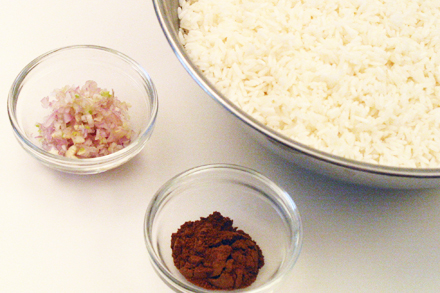
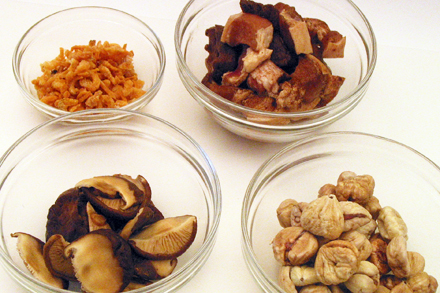
Traditionally zongzi are formed into triangular pyramid shape. Wrapping zongzi can be tricky so I’ve created a step-by-step direction with photos. However before you start wrapping make two bundles of butcher twine made from four strands of about 40 inches long twine each. Gather the center of each bundle and tie a loop for hanging. You should have two bundles with eight stands of twine each.
Wrapping the Dumplings:
- Overlap two bamboo leaves topside up with ends facing in the opposite directions.
- Fold the leaves at about one-third length and twist the bottom around to form a cone.
- Put about one tablespoon of glutinous rice in the cone.
- Put filling on top of the rice.
- Add more rice over the filling.
- Fold the longer end of the bamboo leaves over the cone.
- Fold the leaves along the vein in the middle.
- Bend the excess folded leaves to one side and completely wrap the dumpling.
- Use a butcher twine from the bundle to tie the dumpling tightly.
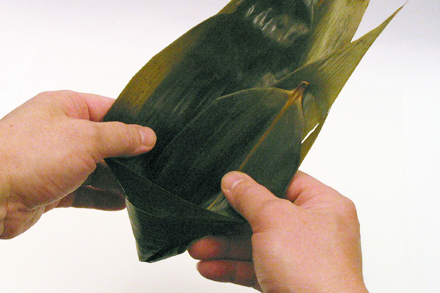
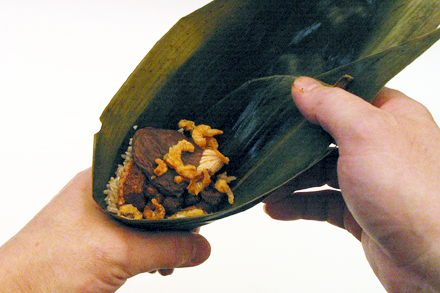
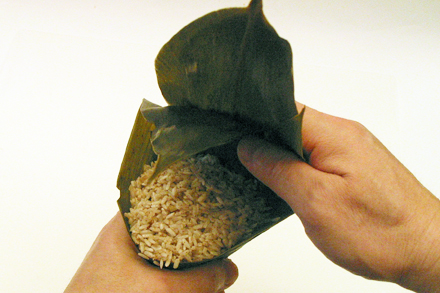
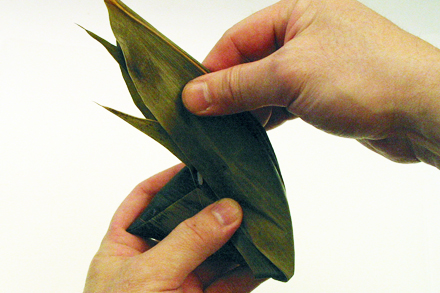
Glutinous Rice Dumpling with Pork (肉粽子)
- Preparation time: 1 hour (plus soaking and marinating over night)
- Slow cooking time: 1 hour 15 minutes
-
Filling
- 1 lb. pork belly
- 8 pieces of dried shiitake mushrooms
- 16 pieces of dried chestnuts
- 1/4 cup dried shrimps
- 1 tablespoon dark soy sauce (老抽)
- 1 tablespoon five-spice powder (五香粉)
- 1 teaspoon salt
-
Rice
- 4 cups glutinous rice
- 4 cups water
- 2 tablespoons chopped shallots
- 1 tablespoon five-spice powder (五香粉)
- 2 teaspoons salt
- 32 dried bamboo leaves
- Cut pork belly into 1/2-inch cubes and set aside. Reconstitute the shiitake mushrooms, chestnuts and dried shrimp separately in enough water to cover completely for about three hours or until soaked thorough. Drain the shiitake mushrooms and remove the stem, then cut them into halves and set aside. Drain the chestnuts and set aside. Drain the shrimps and set aside.
- Put the pork belly, shiitake mushrooms and chestnuts together in a bowl. Add the dark soy sauce, five-spice powder and salt to the mixture and combine well. Marinate over night refrigerated. Soak the glutinous rice and the water over night. Soak the bamboo leaves over night as well in sufficient water to cover all the leaves completely.
- Drain the rice completely the next day and add the minced shallots, five-spice powder and salt. Mix the rice mixture thoroughly. Wrap the dumplings just before cooking. Put about one tablespoon of rice at the bottom of each cone. Then put two to three pieces of pork, one piece each of the shiitake mushroom and chestnut, and about 1 tablespoonful of shrimps over the rice. Cover the filling with another two or three tablespoons of rice. Follow the instructions above to wrap the bamboo leaves and tie the dumplings.
- Boil the dumplings in a large stock pot with enough water to cover completely. Cook for about one hour and fifteen minutes. Drain thoroughly and serve hot. Leftover dumplings can be reheated by steaming over boiling water for about 20 minutes.


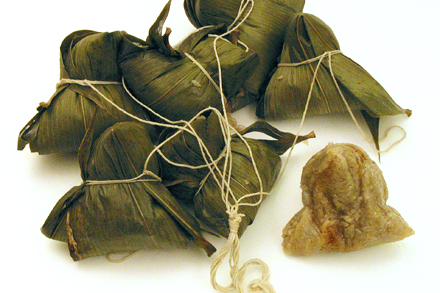
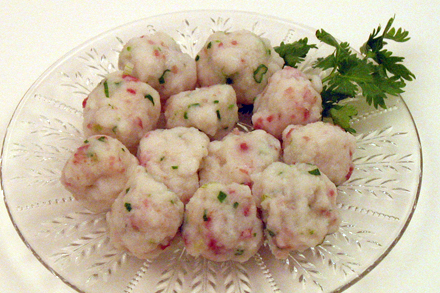
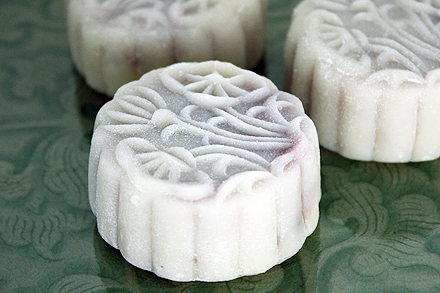
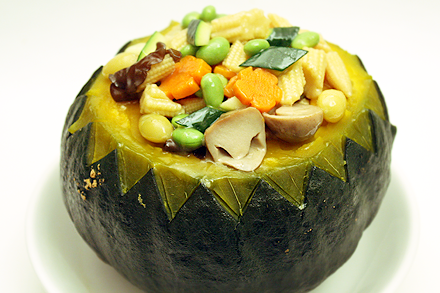
Fascinating! Are these served still wrapped in the bamboo leaves? Some day, I’d like to learn more about the Chinese calendar, too.
Minka, They are often served with the bamboo leaves still on. Most people would unwrap them at the table before eating. Or if you’re in a hurry you can just unwrap a corner of the dumpling and eat on the go.
this is crazy I posted a zongzi yesterday….
doggybloggy, Great minds think alike!
Very interesting history and legend!
These look like the ones that my grandmother and mother would make. Very nostalgic.
This brought back memories from my childhood, when my mom would teach me to make these. 🙂
Really wonderful post.
So what was the secret?
Very funny Greg!
Kian, Hope everything goes well at your side.
Hi, when my grandmother made these, she would make me go buy a bottle of lye solution that she would use to wash (or soak) the bamboo leaves with. What’s the purpose of that? Did you buy dried bamboo leaves? What was the preparation to the leaves before filling them?
The bamboo leaves need to be soaked in water for a few hours. Keep the leaves in the water until you wrap the zongzi. I’ve not heard of using lye solution to soak the leaves.
However lye solution is used in soaking the glutinous rice when making a special type of zongzi. In Chinese it is called 鹼水粽子 or lye dumplings.
I love to eat zongzi. My mum used to make a lot when we were young. I hope to make one of these days. Looks easy here…and mouth-watering.
Oh Wow! This looks heavenly. I could go for this right now.
is there a special string used for this? the Canton style uses bamboo. when my amah taught me about 60 yrs ago she said we had to use a special type so that to gain favor in the eyes of a possible family of prospective new proper in-laws they could see that i would be an acceptable daughter-in-law. ok..but the foot binding was a bit much. any string ideas?
tze hwei yeh
Thank you for your comment. Traditionally these dumplings are tied using straw rope made from rice or wheat plant. But for modern use any butcher twine would work well. It is however very romantic to hear stories of straw rope’s magical power in marriage arrangement.
Thank you for sharing this recipe. I am getting ready to make zongzi and have looked at a few different online recipes. Yours is the most like the kind I grew up eating, but I have one question. Do you really put the pork in raw? Most of the other recipes have you at least partially cook the pork first. Just checking!
Hi JP, In my recipe the filling is marinated overnight to enhance the flavor. Pre-cooking is not necessary. The boiling will cook through the entire zongzi. You can pre-cook the filling in a wok if you are not planning to marinate the filling. I hope you enjoy the zongzi. Happy Dragon Boat Festival!
Is there any way to keep the rice from sticking to the leaves when you peel them off the zongzi?
The oil used in the rice mixture should prevent it from sticking to the leaves. However if overcooked the rice can become very soft and tend to stick to the leaves. So make sure you do not overcook the rice.
do you have an opinion on air or sun drying the sliced/diced shallots? amah insisted on this as a way to enhance the flavor. we have tried it both ways & it does’nt seem to make a lot of difference except that more time & effort is involved.